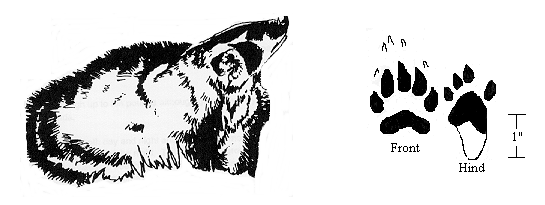

DISTRIBUTION: Found throughout North Dakota. Most abundant in the prairie regions.
HABITAT: Badgers prefer the open prairie, but are occasionally found in wooded areas. They seem to prefer grassland areas but are found on agricultural land as well. They are usually most abundant in an area which has a high population of ground squirrels and small rodents which form the major portion of their diet.
LIFE HISTORY: It is generally thought that badgers breed in the fall and have their young in May or early June following a period of delayed development. The number of young varies from one to seven with an average of four. The young badger apparently spend considerable time in the den (at least six weeks) and by the time they come out on their own, they are well on the way to being grown up. They stay with their parents until late summer and occasionally spend the winter with them.
The badger is a stocky, solid animal and very courageous. Most of them weigh between fourteen and twenty-six pounds.
Badgers are largely nocturnal, but it is not uncommon to see them out during the daytime. They go into partial hibernation in the winter when the ground is frozen and live off the fat they stored up during the fall months.
FOOD HABITS: Although badgers eat mice, insects, birds, eggs, rabbits, etc., their main source of food in North Dakota is the ground squirrels. The young badgers feed largely upon insects until they become adept at digging and catching larger prey species.
SUGGESTED BAITS: Meat that has become tainted but not spoiled, freshly killed ground squirrels, rabbits, etc.
SUGGESTED LURES: Fish oil, natural gland lures. Badgers are most often trapped at their dens. As they do a lot of digging, it is sometimes hard to locate their real den.
In the winter when badgers are prime, and the weather is cold, check the hole for fresh diggings. If the hole is filled from the inside, the badger is living in the hole. Depending on the weather it may take a week or more before the badger will come out of his hole in the winter.
Set your traps to either side of the den as the badger often slides down into the hole and will merely spring a trap set in the center. Conceal your traps with a layer of sifted earth and avoid leaving odors at the set.
When a badger has been digging a lot of holes in an area and you cannot locate its home den, a bait set will often catch it. Put a peace of tainted meat or freshly killed ground squirrel in one of the fresh-dug holes and conceal a trap in the dirt in front of the hole. Conceal the trap chain and stake under the dirt as well as the trap to avoid leaving odors at the set. It is wise to place a concealed trap at each side of the hole also, as you have no way of knowing from which direction the badger will come. Place a drop or two of badger gland lure above the hole to insure that the badger will investigate.
Stake your traps so that the trapped badger cannot get in the hole or you will have a hard time dragging him back out. A trapped badger is quite a fighter and the trap must be staked solidly. A badger in a trap can most easily be killed by shooting it in the head with a .22.
Badgers are often caught in dirt hole sets made for coyotes and foxes.